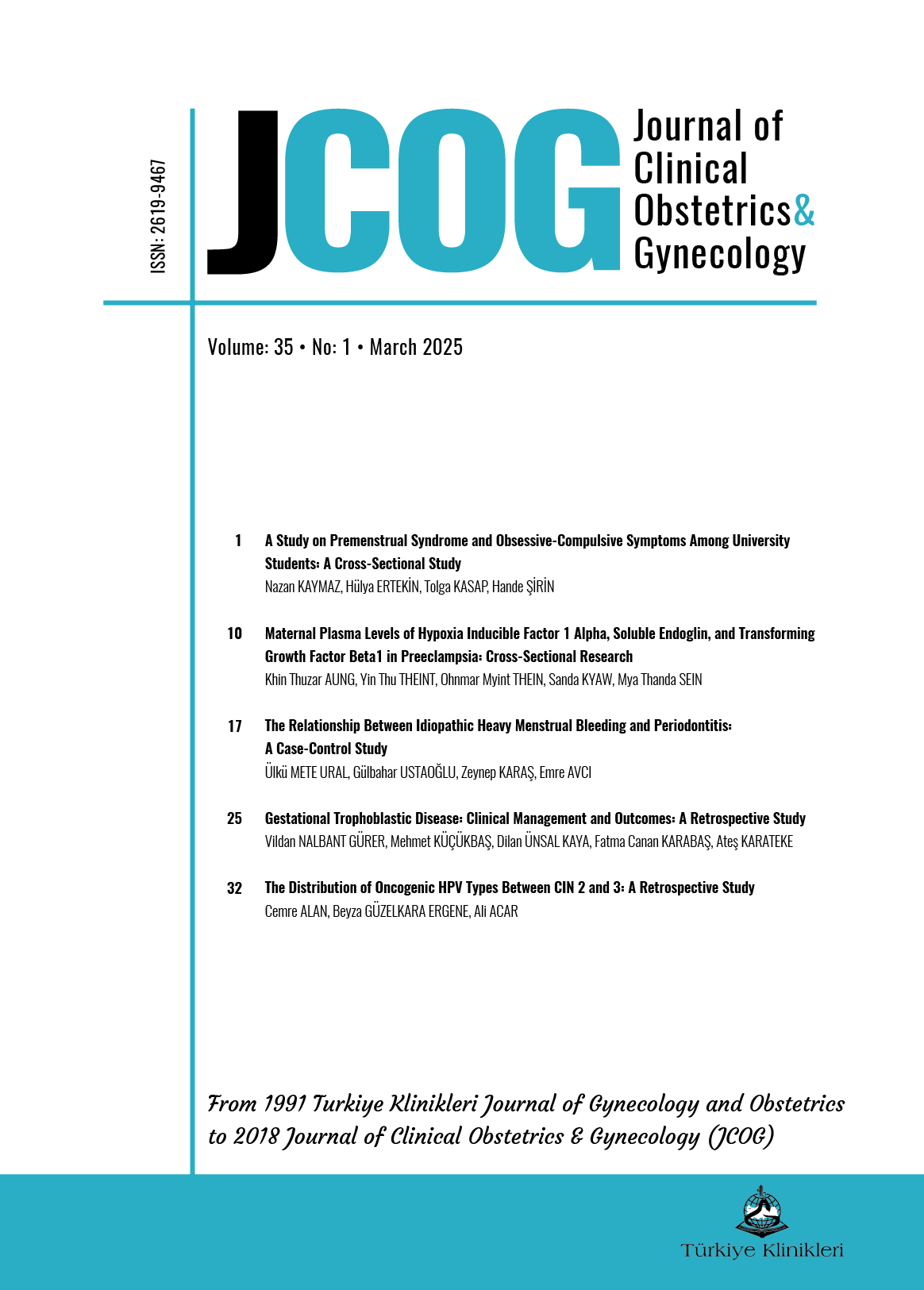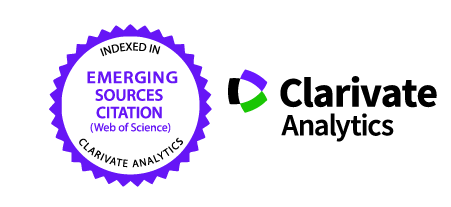Open Access
Peer Reviewed
ORIGINAL RESEARCH
770 Viewed560 Downloaded
Maternal Plasma Levels of Hypoxia Inducible Factor 1 Alpha, Soluble Endoglin, and Transforming Growth Factor Beta1 in Preeclampsia: Cross-Sectional Research
Received: 11 Dec 2024 | Accepted: 14 Mar 2025 | Available online: 18 Mar 2025
JCOG. 2025;35(1):10-6
DOI: 10.5336/jcog.2024-107449
Article Language: EN
Article Language: EN
Copyright Ⓒ 2025 by Türkiye Klinikleri. This is an open access article under the CC BY-NC-ND license (http://creativecommons.org/licenses/by-nc-nd/4.0/)
ABSTRACT
Objective: To determine maternal plasma levels of hypoxia inducible factor 1 alpha (HIF-1α), soluble endoglin (sEng), and transforming growth factor beta1 (TGF-β1) in preeclampsia. Material and Methods: A cross-sectional study was conducted in 30 normal and 30 preeclamptic pregnant women during the third trimester of pregnancy. Plasma levels of HIF 1α, sEng, and TGF-β1 were measured by enzymelinked immunosorbent assay (ELISA). The plasma levels were compared between preeclamptic pregnant women and normal pregnant controls. Correlation between 2 of these parameters were analyzed. Results: Median [interquartile range (IQR)] value of plasma HIF-1α level was significantly higher in preeclampsia (PE) group than that of normal pregnancy group, 37.10 (32.22-44.55) versus 31.09 (29.10-36.55) pg/ml, (p<0.01). The PE group had significantly higher plasma level of sEng than normal pregnancy group [Mean±SD: (14.02±9.05) versus (10.04±3.42) ng/ml, (p<0.05)]. However, there was no statistically significant difference in plasma level of TGF-β1 between PE group [Median (IQR): 4.69 (0.38- 12.04) ng/ml] and normal pregnancy group [Median (IQR): 2.17 (0.392-53.75) ng/ml]. There were no significant correlations between any two of plasma HIF-1α, sEng, and TGF-β1in all pregnant women. Conclusion: Plasma levels of HIF-1α and sEng were significantly higher in PE than that of normal pregnancy. The hypoxia and altered angiogenic balance may be involved in the pathogenesis of preeclampsia.
Objective: To determine maternal plasma levels of hypoxia inducible factor 1 alpha (HIF-1α), soluble endoglin (sEng), and transforming growth factor beta1 (TGF-β1) in preeclampsia. Material and Methods: A cross-sectional study was conducted in 30 normal and 30 preeclamptic pregnant women during the third trimester of pregnancy. Plasma levels of HIF 1α, sEng, and TGF-β1 were measured by enzymelinked immunosorbent assay (ELISA). The plasma levels were compared between preeclamptic pregnant women and normal pregnant controls. Correlation between 2 of these parameters were analyzed. Results: Median [interquartile range (IQR)] value of plasma HIF-1α level was significantly higher in preeclampsia (PE) group than that of normal pregnancy group, 37.10 (32.22-44.55) versus 31.09 (29.10-36.55) pg/ml, (p<0.01). The PE group had significantly higher plasma level of sEng than normal pregnancy group [Mean±SD: (14.02±9.05) versus (10.04±3.42) ng/ml, (p<0.05)]. However, there was no statistically significant difference in plasma level of TGF-β1 between PE group [Median (IQR): 4.69 (0.38- 12.04) ng/ml] and normal pregnancy group [Median (IQR): 2.17 (0.392-53.75) ng/ml]. There were no significant correlations between any two of plasma HIF-1α, sEng, and TGF-β1in all pregnant women. Conclusion: Plasma levels of HIF-1α and sEng were significantly higher in PE than that of normal pregnancy. The hypoxia and altered angiogenic balance may be involved in the pathogenesis of preeclampsia.
KEYWORDS: Hypoxia inducible factor1 alpha; soluble endoglin; transforming growth factor beta; preeclampsia
REFERENCES:
- Brown MA, Magee LA, Kenny LC, Karumanchi SA, McCarthy FP, Saito S, et al; International Society for the Study of Hypertension in Pregnancy (ISSHP). Hypertensive disorders of pregnancy: ISSHP classification, diagnosis, and management recommendations for ınternational practice. Hypertension. 2018;72(1):24-43. [Crossref] [PubMed]
- Abalos E, Cuesta C, Grosso AL, Chou D, Say L. Global and regional estimates of preeclampsia and eclampsia: a systematic review. Eur J Obstet Gynecol Reprod Biol. 2013;170(1):1-7. [Crossref] [PubMed]
- Zhou Y, Damsky CH, Fisher SJ. Preeclampsia is associated with failure of human cytotrophoblasts to mimic a vascular adhesion phenotype. One cause of defective endovascular invasion in this syndrome? J Clin Invest. 1997;99(9):2152-64. [Crossref] [PubMed] [PMC]
- Palei AC, Spradley FT, Warrington JP, George EM, Granger JP. Pathophysiology of hypertension in pre-eclampsia: a lesson in integrative physiology. Acta Physiol (Oxf). 2013;208(3):224-33. [Crossref] [PubMed] [PMC]
- Greer SN, Metcalf JL, Wang Y, Ohh M. The updated biology of hypoxia-inducible factor. EMBO J. 2012;31(11):2448-60. [Crossref] [PubMed] [PMC]
- Rajakumar A, Brandon HM, Daftary A, Ness R, Conrad KP. Evidence for the functional activity of hypoxia-inducible transcription factors overexpressed in preeclamptic placentae. Placenta. 2004;25(10):763-9. [Crossref] [PubMed]
- Akhilesh M, Mahalingam V, Nalliah S, Ali RM, Ganesalingam M, Haleagrahara N. Hypoxia-inducible factor-1α as a predictive marker in pre-eclampsia. Biomed Rep. 2013;1(2):257-8. [Crossref] [PubMed] [PMC]
- Rath G, Aggarwal R, Jawanjal P, Tripathi R, Batra A. HIF-1 alpha and placental growth factor in pregnancies complicated with preeclampsia: a qualitative and quantitative analysis. J Clin Lab Anal. 2016;30(1):75-83. [Crossref] [PubMed] [PMC]
- Wang A, Rana S, Karumanchi SA. Preeclampsia: the role of angiogenic factors in its pathogenesis. Physiology (Bethesda). 2009;24:147-58. [Crossref] [PubMed]
- Maynard SE, Karumanchi SA. Angiogenic factors and preeclampsia. Semin Nephrol. 2011;31(1):33-46. [Crossref] [PubMed] [PMC]
- ACOG Committee on Obstetric Practice. ACOG practice bulletin. Diagnosis and management of preeclampsia and eclampsia. Number 33, January 2002. American College of Obstetricians and Gynecologists. Int J Gynaecol Obstet. 2002;77(1):67-75. [Crossref] [PubMed]
- Aghaeepour N, Lehallier B, Baca Q, Ganio EA, Wong RJ, Ghaemi MS, et al. A proteomic clock of human pregnancy. Am J Obstet Gynecol. 2018;218(3):347.e1-347.e14. [Crossref] [PubMed]
- Romero R, Erez O, Maymon E, Chaemsaithong P, Xu Z, Pacora P, et al. The maternal plasma proteome changes as a function of gestational age in normal pregnancy: a longitudinal study. Am J Obstet Gynecol. 2017;217(1):67.e1-67.e21. [Crossref] [PubMed] [PMC]
- Tianthong W, Phupong V. Serum hypoxia-inducible factor-1α and uterine artery Doppler ultrasound during the first trimester for prediction of preeclampsia. Sci Rep. 2021;11(1):6674. [Crossref] [PubMed] [PMC]
- Semenza GL. Hydroxylation of HIF-1: oxygen sensing at the molecular level. Physiology (Bethesda). 2004;19:176-82. [Crossref] [PubMed]
- Caniggia I, Mostachfi H, Winter J, Gassmann M, Lye SJ, Kuliszewski M, et al. Hypoxia-inducible factor-1 mediates the biological effects of oxygen on human trophoblast differentiation through TGFbeta(3). J Clin Invest. 2000;105(5):577-87. [Crossref] [PubMed] [PMC]
- Ietta F, Wu Y, Winter J, Xu J, Wang J, Post M, et al. Dynamic HIF1A regulation during human placental development. Biol Reprod. 2006;75(1):112-21. [Crossref] [PubMed]
- Cheng MH, Wang PH. Placentation abnormalities in the pathophysiology of preeclampsia. Expert Rev Mol Diagn. 2009;9(1):37-49. [Crossref] [PubMed]
- Alasztics B, Kukor Z, Pánczél Z, Valent S. A praeeclampsia kórélettana a kétlépcsős modell tükrében [The pathophysiology of preeclampsia in view of the two-stage model]. Orv Hetil. 2012;153(30):1167-76. Hungarian. [Crossref] [PubMed]
- Ashur-Fabian O, Yerushalmi GM, Mazaki-Tovi S, Steinberg DM, Goldshtein I, Yackobovitch-Gavan M, et al. Cell free expression of hif1α and p21 in maternal peripheral blood as a marker for preeclampsia and fetal growth restriction. PLoS One. 2012;7(5):e37273. [Crossref] [PubMed] [PMC]
- Ohh M, Park CW, Ivan M, Hoffman MA, Kim TY, Huang LE, et al. Ubiquitination of hypoxia-inducible factor requires direct binding to the beta-domain of the von Hippel-Lindau protein. Nat Cell Biol. 2000;2(7):423-7. [Crossref] [PubMed]
- Jaakkola P, Mole DR, Tian YM, Wilson MI, Gielbert J, Gaskell SJ, et al. Targeting of HIF-alpha to the von Hippel-Lindau ubiquitylation complex by O2-regulated prolyl hydroxylation. Science. 2001;292(5516):468-72. [Crossref] [PubMed]
- Levine RJ, Lam C, Qian C, Yu KF, Maynard SE, Sachs BP, et al; CPEP Study Group. Soluble endoglin and other circulating antiangiogenic factors in preeclampsia. N Engl J Med. 2006;355(10):992-1005. Erratum in: N Engl J Med. 2006;355(17):1840. [Crossref] [PubMed]
- Hasheesh NM, Waly M, Gouda M, Taweel NE. Maternal serum soluble endoglin in patients with pre-eclampsia and gestational hypertension and its relation to doppler study of the fetomaternal circulation. Med. J. Cairo Univ. 2010;78 (2):117-21. [Link]
- Sachan R, Patel ML, Verma P, Dheeman S, Gupta P. Association of serum soluble endoglin levels with adverse foetomaternal outcome in preeclampsia and eclampsia. Journal of Advances in Medicine and Medical Research. 2016;18(4):1-9. [Crossref] [PubMed]
- Leaños-Miranda A, Navarro-Romero CS, Sillas-Pardo LJ, Ramírez-Valenzuela KL, Isordia-Salas I, Jiménez-Trejo LM. Soluble endoglin as a marker for preeclampsia, its severity, and the occurrence of adverse outcomes. Hypertension. 2019;74(4):991-7. [Crossref] [PubMed]
- Venkatesha S, Toporsian M, Lam C, Hanai J, Mammoto T, Kim YM, et al. Soluble endoglin contributes to the pathogenesis of preeclampsia. Nat Med. 2006;12(6):642-9. Erratum in: Nat Med. 2006;12(7):862. [Crossref] [PubMed]
- Kapur NK, Morine KJ, Letarte M. Endoglin: a critical mediator of cardiovascular health. Vasc Health Risk Manag. 2013;9:195-206. [Crossref] [PubMed] [PMC]
- Akhurst RJ, FitzPatrick DR, Gatherer D, Lehnert SA, Millan FA. Transforming growth factor betas in mammalian embryogenesis. Prog Growth Factor Res. 1990;2(3):153-68. [Crossref] [PubMed]
- Singh M, Orazulike NC, Ashmore J, Konje JC. Changes in maternal serum transforming growth factor beta-1 during pregnancy: a cross-sectional study. Biomed Res Int. 2013;2013:318464. [Crossref] [PubMed] [PMC]
- Benian A, Madazli R, Aksu F, Uzun H, Aydin S. Plasma and placental levels of interleukin-10, transforming growth factor-beta1, and epithelial-cadherin in preeclampsia. Obstet Gynecol. 2002;100(2):327-31. [Crossref] [PubMed]
- Peraçoli MT, Menegon FT, Borges VT, de Araújo Costa RA, Thomazini-Santos IA, Peraçoli JC. Platelet aggregation and TGF-beta(1) plasma levels in pregnant women with preeclampsia. J Reprod Immunol. 2008;79(1):79-84. [Crossref] [PubMed]
- Ayatollahi M, Samsami Dehaghani A, Tabei Z. Maternal Serum Levels of Transforming Growth Factor β1 (TGF β1) in Normal and Preeclamptic Pregnancies. Iranian Journal of Immunology. 2005;2(1):50-5. [Link]
- Powe CE, Levine RJ, Karumanchi SA. Preeclampsia, a disease of the maternal endothelium: the role of antiangiogenic factors and implications for later cardiovascular disease. Circulation. 2011;123(24):2856-69. [Crossref] [PubMed] [PMC]
MENU
POPULAR ARTICLES
MOST DOWNLOADED ARTICLES





This journal is licensed under a Creative Commons Attribution-NonCommercial-NoDerivatives 4.0 International License.










